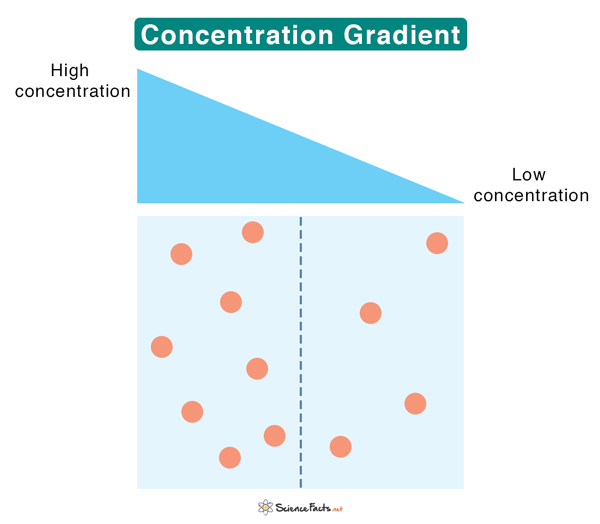Concentration Gradient
A concentration gradient is a phenomenon where the concentration of particles is higher in one area compared to another. As physics dictates, particles travel from the higher to a lower concentration region during passive transport.
Generally, a gradient is how much something changes when that something moves from one region to another. Therefore, concentration gradient refers to how much the concentration changes when something moves from one region to another. In biology, concentration gradient refers to the gradual change in a solute’s concentration in a solution as a function of the distance the molecules traverse.
The concentration gradient is important because it enables us to understand how particles move in random motion in a solution. A concentration gradient ceases to exist when there is no net movement.
Example of Concentration Gradient
When we drop a few drops of food dye in a glass of water, the dye diffuses along the concentration gradient. The dye starts from where it exists in its highest concentration (the brightest color). It diffuses to where it occurs in its lowest concentration (clear water). The diffusion will continue until the concentration of the dye becomes uniform in all directions of the water.
Concentration and Gradient and Diffusion
Diffusion is the process by which atoms, ions, and molecules move from a region of high concentration to a region of low concentration, down the concentration gradient. Generally, diffusion takes into account the movement of solutes. The diffusion rate is fastest when the concentration gradient is steepest and the temperature is the highest.
Concentration Gradient and Osmosis
Osmosis is the spontaneous process in which the solvent molecules move from a region of low solute concentration to a region of high solute concentration. When a semi-permeable membrane separates two solutions of different concentrations, water molecules pass through the membrane from a low solute concentration region to a high solute concentration region. In this way, the concentrations become equal and chemical equilibrium is achieved.
Concentration Gradient and Active Transport
Active transport is a cellular transport process in which particles are moved from a low concentration region to a high concentration region against the concentration gradient. In other words, the particles display an “uphill” movement. Since the movement is against the concentration gradient, this process requires chemical energy with the help of a membrane protein.
Functions of Concentration Gradient
- Concentration gradient stores energy that molecules utilize to achieve equilibrium.
- Cell organisms use concentration gradients to move substances in and out of cells.
- Organisms can also “harvest” the energy of the concentration gradient to power other reactions.
-
References
Article was last reviewed on Friday, February 17, 2023








